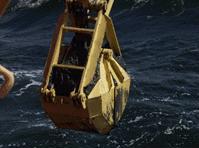Difference between revisions of "Sampling tools for the marine environment"
| Line 133: | Line 133: | ||
==Bottom Grabs== | ==Bottom Grabs== | ||
| + | [[Image:grab.jpg|right|grab|frame]] | ||
| + | <ref name=marbef>http://www.marbef.org/qa/documents/ConductofsurveysatMAEsites.pdf </ref>Grab sampling is the simple process of bringing up surface sediments from the seafloor. Once it is launched, the jaws of the grab sampler open and it descends to the seafloor. A spring closes the jaws, and they trap sediments or loose substrate. The grab sampler is then brought up to the surface where its contents are studied in detail. | ||
| + | |||
| + | |||
| + | |||
| + | |||
| + | |||
| + | |||
| + | |||
| − | |||
===the Hamon grab=== | ===the Hamon grab=== | ||
Revision as of 15:21, 6 September 2007
[1]All methods of physical capture are inherently selective. Small fish may pass through large-meshed nets; large fish may out-swim trawls; gill nets will catch fish mainly of a certain size range. Fish may react differently to fishing gear with respect to species, size, biological state, environmental conditions including ambient light and the acoustic noise field, among many other factors.
[2]|This is why organisms are subdivided out of practical necessity, in that the sampling approach and sample size that are appropriate for one group are often inappropriate for another. The disparity in appropriate techniques for different sizes of groups of organisms has contributed greatly to the paucity of studies on more than one taxonomic grouping at a given locale.
Unfortunately, where conflicting conclusions have been drawn patterns in different groups of organisms, it is rarely possible to know whether the patterns truly vary among groups or merely reflect differences in sampling efforts
Sampling tools for pelagic organisms
Midwater or pelagic trawl
[1]A midwater trawl is a set of gear that is used to catch fish that are between the sea surface and bottom, generally staying clear of the bottom. Occasionally, midwater trawls are configured with floats to perform catching in the shallow-surface layer.
[3]A midwater trawl consists of a cone shaped body, normally made of four panels, ending in a codend with lateral wings extending forward from the opening.
[1]Midwater and bottom trawls (see further) have many parts in common, if differing in dimensions and shapes due to their different fishing objects and hydrodynamic regimes of operation. Midwater trawls are designed to catch fish in the midwater column, hence must be capable of rapid maneuvering while maintaining an open net mouth. This is reflected in differences in the body of the net, rigging, and even trawl doors.


Plankton nets
[4]Plankton nets are a modification on the standard trawl used to collect planktonic organisms, of nearly any size, intact. Towed by a research vessel, plankton nets have a long funnel shape that allows them to catch differently sized plankton simply by changing the mesh size of the net. At the end of the funnel is a collection cylinder called a cod-end.
Ring net
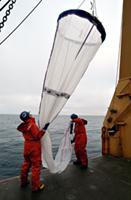
[1]The ring net consists of a fine-meshed bag attached at its mouth, or opening, to a metallic ring. The net itself is terminated in a bottle or jar where the unfiltered plankton and other particulate matter are collected.
The net is usually deployed vertically for non-quantitative purposes from a platform, such as a vessel or pier. It may also be towed, although lacking in devices for controlling its passage through the water column, which is otherwise determined by hydrodynamic forces generated naturally during towing or hauling. Towing applications are mainly non-quantitative.
Bongo nets
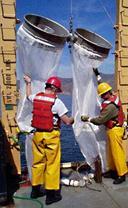
In order to obtain quantitative samples of phytoplankton, zooplankton, other invertebrates, and large fish, it is critical to estimate the volume of water that is filtered during the sample. Most bongo and ring nets are deployed with mechanical or electronic flow meters positioned in the mouth of the net to quantify the volume of water filtered.
Multiple Opening/Closing Nets and Environmental Sampling System (MOCNESS)
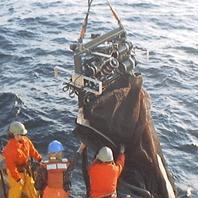
[1]The Multiple Opening/Closing Nets and Environmental Sampling System, which is generally known by its acronym MOCNESS, is an operational, widely used system for capturing plankton at specific depths on the command of the operator. It also routinely carries a number of sensors for measuring environmental parameters as it is towed. These sensors measure, for example, conductivity, temperature, pressure, fluorescence, optical transmission, dissolved oxygen, and light levels.
Neuston nets
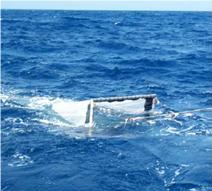
[6]These types of nets are towed at the surface to sample neuston. Neuston are those organisms associated with the water surface, where they are supported by surface tension. Scientist can determine the number of organisms per unit volume of water filtered.
Drift nets
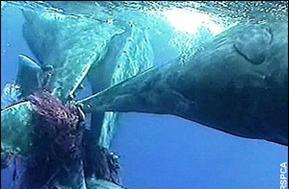
[8] Drift nets are not set or fixed in any way, are in fact ‘mobile’, and they are allowed to drift with the prevailing currents. Drift nets are used on the high seas for the capture of a wide range of fish including tuna, squid and shark, and off north-east England for salmon An EU-wide ban on all drift nets was introduced from January 2002 but problems still exist.
Gill nets
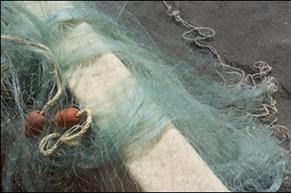
[8]Gill nets are walls of netting which may be set at or below the surface, on the seabed, or at any depth in between. Gill netting is probably the oldest form of net fishing, having been in use for thousands of years. True gill nets catch fish that attempt to swim through the net, which are caught if they are of a size large enough to allow the head to pass through the meshes but not the rest of the body. The fish then becomes entangled by the gills as it attempts to back out of the net. The mesh size used depends upon the species and size range being targeted.
Fyke nets
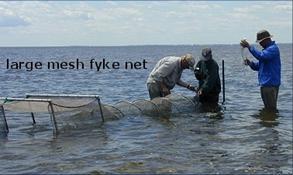
Sampling tools for benthic organisms
[11]The type of gear selected for sampling seabed substrata and the benthic macrofauna at aggregate dredging sites is primarily determined by the hardness/ compactness of the substrata. Whilst a wide variety of sampling methods are available, only a small proportion of these have the ability to effectively collect samples from areas of relatively coarse sediments which are characteristic of dredging sites. In certain situations, it may be necessary to use more than one technique in order to sample the full range of benthic organisms present in an area.
Bottom Grabs
[11]Grab sampling is the simple process of bringing up surface sediments from the seafloor. Once it is launched, the jaws of the grab sampler open and it descends to the seafloor. A spring closes the jaws, and they trap sediments or loose substrate. The grab sampler is then brought up to the surface where its contents are studied in detail.
the Hamon grab
[11]The Hamon grab is the recommended tool for sampling the benthic macro-infauna from coarse substrata. This grab consists of a rectangular frame forming a stable support for a sampling bucket attached to a pivoted arm. On reaching the seabed, tension in the wire is released which activates the grab. Tension in the wire during in hauling then moves the pivoted arm through a rotation of 90°, driving the sample bucket through the sediment. At the end of its movement, the bucket locates onto an inclined rubber-covered steel plate, sealing it completely. This results in the sediment rolling towards the bottom of the sample bucket, thereby reducing the risk of gravel becoming trapped between the leading edge of the bucket and the sample retaining plate, and thus preventing part of the sample being washed out. Weights are attached to the grab to minimize the lateral movement of the supporting frame during sample collection. A drawback of the Hamon grab is that the sediment sample is mixed during the process of collection and retrieval, thereby precluding the examination or sub-sampling of an undisturbed sediment surface.
References
- ↑ 1.0 1.1 1.2 1.3 1.4 1.5 1.6 1.7 1.8 http://www.usm.maine.edu/gulfofmaine-census/Docs/Technology/STPC.htm#bottomtraw
- ↑ Steele, J.H.; Thorpe, S.A.; Turekian, K.K. (Ed.). (2001). Encyclopedia of ocean sciences. Academic Press: San Diego, CA (USA). 6 vol. p748-749
- ↑ 3.0 3.1 3.2 http://www.fao.org/fi/website/FIRetrieveAction.do?dom=geartype&fid=207 Cite error: Invalid
<ref>tag; name "fao" defined multiple times with different content Cite error: Invalid<ref>tag; name "fao" defined multiple times with different content - ↑ http://www.coml.org/edu/tech/collect/planktonnets.htm
- ↑ http://oceanexplorer.noaa.gov/technology/vessels/mcarthur/mcarthur.html
- ↑ 6.0 6.1 http://www.dnr.sc.gov/marine/sertc/sampling%20methods.pdf
- ↑ http://www.telegraph.co.uk/news/main.jhtml?xml=/news/2007/04/18/nnet118.xml
- ↑ 8.0 8.1 http://www.fishonline.org/caught_at_sea/methods/
- ↑ http://the.honoluluadvertiser.com
- ↑ http://glei.nrri.umn.edu/default/fykenet.htm
- ↑ 11.0 11.1 11.2 http://www.marbef.org/qa/documents/ConductofsurveysatMAEsites.pdf
